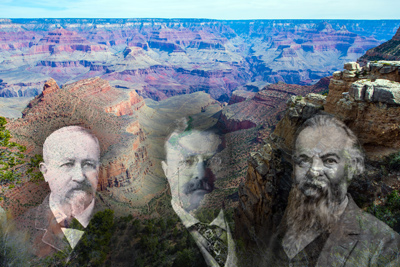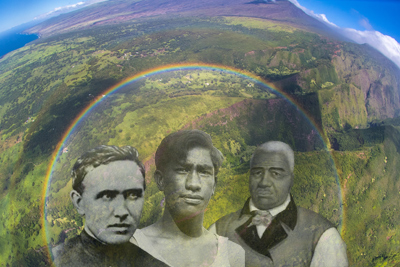Discover the Historical Figures of Las Vegas, Grand Canyon, Hawaii, and California
Las Vegas, Grand Canyon, Hawaii, and California are four entirely different travel destinations and bucket list experiences, yet
they have so much in common! Not only can you find various stunning landscapes and endless adventures while visiting each location,
but all four have a rich and fascinating history.
How much do you know about Las Vegas, Grand Canyon, Hawaii or California? Here are twelve key figures who have contributed to the
growth and development of these major tourist hotspots.
Las Vegas
Howard Hughes - Las Vegas (1905-1976)
In addition to the top-notch entertainment you can find scattered throughout the Strip and historic Downtown, you can also immerse
yourself in the world of gaming. One of the most famous icons of the 20th century in Las Vegas was Howard Hughes. Hughes is a
notable figure in Las Vegas history because he helped clean up Nevada's gaming image and shifted the town's identity from the
wild west to a sophisticated cosmopolitan city.
Hughes played a vital role in allowing corporations to acquire casinos and revitalizing the state's economy. He purchased
significant properties, including Desert Inn, Sands, New Frontier, and Silver Slipper. In addition, he funded a medical school
and a community college, and aided in the development of the beautiful community of Summerlin.
Frank Sinatra (1915 -1998)
You have heard the name, and if you are a "Sin City" enthusiast, you know there is an entire street on the iconic Strip that is
named after him. Bringing what it truly meant to entertain to a whole other level, Frank Sinatra quickly became another icon of
the 20th century in Las Vegas.
Sinatra made his first Vegas headlining appearance at the Desert Inn in 1951 and, through his music, truly exemplified what it
meant for the city to be a sophisticated adult playground. Because of his impeccable style and swing, visitors from near and far
traveled to Vegas to experience his shows. It’s the "City of Entertainment" for a reason!
Elvis Presley (1935-1977)
Like Sinatra, another well-known figure contributed significantly to Las Vegas, earning its title as the City of Entertainment.
In 1956, beloved superstar Elvis Presley performed his first residency at the New Frontier Hotel. However, due to conservative
culture at the time, he did not gain popularity until the late 60s.
After some time, Elvis agreed to a 5-year residency at the new International Hotel. This time, he captured thousands' hearts and
sold out 636 of his shows.Today, much of Las Vegas is still inspired by "The King" and continues to honor his legacy. Finding an
Elvis impersonator walking the Strip or Fremont Street Experience is not uncommon. In addition, Elvis weddings are unique and
trendy amongst couples looking to tie the knot in Vegas!
Grand Canyon
Jon Wesley Powell (1834-1902)
As you can imagine, navigating the Grand Canyon would be complicated and lengthy. However, in 1869, American explorer and geologist;
Jon Wesley Powell accomplished what seemed like an impossible task! Powell led the first official expedition through the entire Grand
Canyon, which took approximately 3 months to complete.
Powell and his team of 10 men completed the United States government-sponsored expedition along the mighty Colorado River to discover
the expansive geology of the Grand Canyon. In fact, he was the Director of the U.S. Geological Survey from 1881 to 1894. Powell once
said, "The wonders of the Grand Canyon cannot be adequately represented in symbols of speech, nor by speech itself." This famous quote
still resonates with people from all over the world and is why it's on many visitors' must-see bucket list.
Clarence Dutton (1841-1912)
The Grand Canyon is famous for leaving its visitors in awe and completely speechless. Most people would agree that there are no words
to describe the beauty and majesty of this natural wonder, yet somehow, Clarence Dutton did just that.
Dutton is a famous geologist who worked for the United States Geological Survey and, in 1882, wrote a paper on the Cenozoic history of
the Grand Canyon District. His creative descriptions of the Grand Canyon captured many people's attention and attracted travelers to
experience the geology of the Grand Canyon for themselves.

President Theodore Roosevelt (1858-1919)
America's National Parks play an essential role in everyday life and allow citizens and tourists to explore some of the most beautiful
parts of the country. Like all National Parks, the Grand Canyon protects wildlife, habitats, and nature from destruction and human impact.
In 1908, President Theodore Roosevelt declared 800,000 acres of the Grand Canyon a national monument. President Roosevelt deemed the
Grand Canyon a National Park, intending to preserve it for future use and enjoyment. He once stated, "Let this great wonder of nature
remain as it now is. You cannot improve on it. But what you can do is keep it for your children, your children's children, and all who
come after you as the one great sight which every American should see."
Hawaii
King Kamehameha I (1758-1819)
Most people would agree that Hawaii is one of the most peaceful places in the world. However, hundreds of years ago, the islands of Hawaii
were at frequent war with one another. Ancient Hawaiian chiefs would attack rivaling islands and even battle factions of their own. It
wasn't until 1801 that King Kamehameha I, a righteous warrior, diplomat, and leader, would unite all the Hawaiian Islands into one royal
kingdom after years of conflict.
His strength and desire to bring peace to the islands were driven by his love for the Hawaiian people. Because he was "Hawaii's greatest
king," there are four King Kamehameha statues on Oahu, Kohala, Hilo, and Washington D.C.. In honor, every June 11th, the King Kamehameha
statues are ceremoniously draped with flower leis.
Saint Damien (1840-1889)
In the late 1800s, a contagious disease, leprosy, plagued the Hawaiian islands. Natives infected with leprosy were forced to isolate
themselves on the island of Molokai on Kalawao. In 1873, a Belgium priest arrived to offer medical aid. However, Father Damien gave so much
more and provided the islanders with a sense of hope for the future.
Father Damien provided medical care, buried the dead, and found time to build homes, schools, and water systems. Unfortunately, after
16 years of selflessness and service, he succumbed to the disease that had brought him to the Hawaiian Islands. He was later canonized
and granted sainthood in Rome in October of 2009 and is now known as one of the most influential historical figures on Maui.

Duke Kahanamoku (1890-1968)
People from all over the world recognize the islands of Hawaii as the birthplace of modern surfing. Duke Kahanamoku is one of Hawaii's
most beloved heroes as he came to be the world’s greatest waterman, a master of swimming, surfing, and outrigger canoe paddling.
During his first competition, Kahanamoku grew up swimming in Waikiki and broke the world record in the 100-yard freestyle. He eventually
went on to win multiple gold and silver medals, including Olympic gold for the 100-meter freestyle in 1912.
Kahanamoku eventually became known as "the father of modern surfing". He was one of the pioneers of Waikiki Beach Boys, watermen who
taught visitors how to surf and canoe at Waikiki Beach. His accomplishments made him the first to be inducted into the Surfing Hall of
Fame and the Swimming Hall of Fame.
Now that you are familiar with some of the rich histories behind the iconic travel destinations of Las Vegas, the Grand Canyon, and Hawaii,
you will have a whole new perspective on your next visit!
California
William Wrigley Jr. (1861-1932)
The transformation of Catalina Island into a renowned tourist destination in Southern California was driven by the vision of one
man. William Wrigley Jr., who took over the Santa Catalina Island Company in 1919, poured significant resources into enhancing
its infrastructure, tourism offerings, and conservation efforts. This investment turned Catalina into a favored retreat for
Hollywood's elite during the 1930s-1950s and continues to attract tourists from all over the world.
Wrigley's dedication to preserving the island's natural beauty led to the establishment of the Catalina Island Conservancy.
Leveraging his marketing prowess, including his chewing gum empire, he successfully promoted Catalina as a glamorous getaway.
Today, Catalina remains a testament to Wrigley's foresight, captivating visitors with its natural wonders and leisure
opportunities
Phineas Banning (1830-1885)
The Port of Los Angeles stands as one of the globe's most bustling seaports and serves as a primary entry point for international
trade in North America. Phineas Banning, a prominent American businessman and entrepreneur, played a pivotal role in establishing
the town of Wilmington. Moreover, his relentless determination and visionary leadership laid the groundwork for the evolution of
what would later be recognized as one of the world's busiest ports.
Eventually earning the nickname "The Father of the Port of Los Angeles," Banning's legacy remains integral to the port's storied
history and enduring success. Today, the Port of Los Angeles occupies 7,5000 acres of land and water with 43 miles of waterfront.
Eunice Sato (1921-2021)
Located in Los Angeles County, the city of Long Beach ranks as the 43rd most populous city in the United States. Renowned for its
vast shipping port, waterfront attractions, historic Queen Mary, and the esteemed Aquarium of the Pacific, Long Beach boasts a
diverse array of offerings. Eunice Sato made history by serving as the mayor of Long Beach from 1980 to 1982, marking her as
the first Asian-American female mayor of a major American city and the first female mayor of Long Beach.
During the tough economic times of the 1970s to 1980s, Sato helped revive the city. She didn't just focus on governing but also
volunteered for many organizations, including leading the California Conference for Equality and Justice. In 1991, she was
appointed to the National Advisory Council of Educational Research due to her expertise. Her efforts to improve Japan-US
relations were recognized in 1996 when she received an award from the Japanese government.
Having gained insight into the fascinating histories of renowned travel destinations like Las Vegas, the Grand Canyon, Hawaii,
and California, your next visit will be enriched with a fresh perspective!